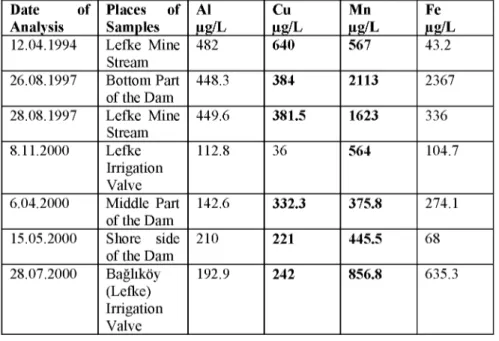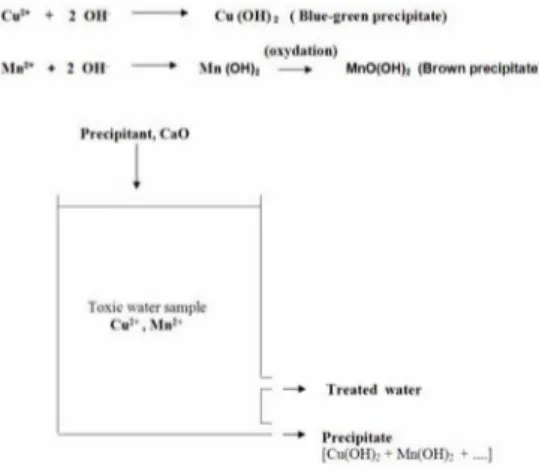1 (1), 2007, 88-93
©BEYKENT UNIVERSITY
REMOVAL OF TOXIC COPPER AND
MANGANESE IONS FROM
LEFKE-GEMIKONAGI DAM WATER
Selahattin Gökmen
Beykent University, Faculty of Engineering and and Architecture, Chemical Engineering Department,Nilay Taşer
Girne American University, GAC, Karaoğlanoğlu,Girne / TRNC
(CYPRUS) Ayazağa, İstanbul / TURKEY
ABSTACT
In this study, Lefke-Gemikonagi dam water which contains Copper and Manganese ions in high concentrations ( Copper : 193.7 ^g/L , Manganese : 855.9 ^g/L etc.) was treated with Calcium oxide and these ions were precipitated. After treatment, dam water can be used as agricultural irrigation water in this area without any risk of toxicity.
Bu çalışmada, tarımsal amaçlı sulama suyu olarak kullanılan Lefke-Gemikonağı ( KKTC) baraj suyunda bulunan yüksek derişimlerdeki bakır ve mangan iyonları ( bakır iyonu : 193.7 ^g/L , mangan iyonu :855.9 ^g/L vb.) kalsiyum oksitle ( CaO ) çöktürülüp uzaklaştınlmıştır.Yapılan bu kimyasal çöktürme işleminden sonra, baraj suyu zehirlilik bakımından uluslararası standartlara uygun hale getirildiğinden; hiçbir zehirlilik riski taşımadan tarımsal sulama suyu olarak kullanılabilecektir.
1. INTRODUCTION
The name of the island "Cyprus" comes from "copper" mines which are found around the Lefke distirict in Northhern Cyprus ( TRNC = KKTC).
Copper mines were extracted and concentrated by CMC ( Cyprus Mining Corporation Company) between 1961-1971. Beside the copper ores, gold and pyrite ores were also obtained as side-products.
CMC is directly responsible for environmental pollution problems that still threat the nature and of course human health seriously. In 1971, The Union of Lefke farmers and later Lefke municipality applied to international
OZET
courts for irresponsibility of CMC about environmental pollution but there was no positive response at all.
In 1974, with the advent of war in the area, the dream came to an abrupt halt and the real trouble began. Claiming that CMC were forcibly ejected from the island, the company left all as it stood and has never returned to Northern Cyprus. The fact that they refused point black to accept any form of responsibility whatsoever caused environmental problems since they left the island and yet still claim compensation rights for economic and equipment losses.
The people who live in Lefke district have been suffering from environmental pollution for a long time. Agricultural irrigation water, sea water, soil and air pollution problems cause serious and harmful damages on the environment and the habitants' lives around this area.
The concentrations of Copper and Manganese ions in Gemikonagi dam water is much higher than toxic levels that are indicated in international standards. In addition to that, Hydrogen Sulfide ( H2S ) and other sulfurous
gases produced biochemically are continuously emit from the huge sulfurous solid waste heaps in this area.
Gemikonagi dam that is near the Lefke having 4 million m3 of water
capacity was built in 1994 for agricaltural purposes because of rainless and dry climate of Cyprus. Planned irrigation area around the dam is nearly 130 hectares. According to chemical analysis reports
made by Govermental Laboratory ( in Nicossia) and different Universities; concentration of copper and manganese ions in dam water was found 3-5 times more than standard toxic limits. Some results of analysis are given in Table 1
[5,6].
According to chemical analysis made before and our investigation Gemikonagi Dam waters have toxic heavy metal ions which are Copper and Manganese ions at the so high levels in comparison with agricultural irrigation water pollution limits.
The presence of heavy metal ions in the environment has been of great concern because their toxic nature and other adverse on many life forms. For instance, excessive intake of copper causes an accumulation inthe liver and it is also toxic to organisms. Because the average daily intake of copper is about 2.5 mg/day, and because water can contain up to 1 mg/L copper, the daily intake from water can exceed that from food. The general health hazard from copper intake at a few people with a copper metabolism disorder -Wilson's disease - can be adversely affected by ingestion of even trace amount of copper [1]. Wilson's disease is characterized with the accumulation of copper in liver, brain and kidneys and other organs [2]. On the other hand,copper is a trace element which has an important role in a lot of enzyme systems. The main copper sources as a foodstuff are liver, kidney, sea products ( having shell), chocolate and wheat. Average copper intake on a normal diet changes 0.6-3 mg/day that altering from country to country [3].
Ingestion of manganese in moderate excess of 3-7 mg/day is not considered harmful, although in some unusual geological situations (as mining sites) very high manganese concentrations can occur and cause the disease manganism [ 1]. Manganese should not be supplemented if the patient has liver disease with elevated bilirubin. On the other hand, in case of plants, the uptake of excess amounts of manganese cause the problem of manganese toxicity showing interveinal or marginal chlorosis, necrotic blotching, and leaf cupping [4].
Precipitation, oxidation / reduction, ion exchange, filtration, membrane separation, evaporation, electrochemical and biosorption methods are used for removing or recovering toxic heavy metals from the wastes. There are some advantages and disadvantages amongst these methods [5].
In our study, some Gemikonagi dam toxic water samples containing in high concentrations of copper and manganese ions were investigated and tried to remove these ions for agricultural irrigation water by precipitation with calcium oxide, CaO.
Toxic limit concentrations of some metal ions for long term agricultural irrigation waters of Gemikonagi Dam Water are shown in Table 2 [6,7].
Table 1 : Some Results of Chemical Analysis of Gemikonagi Dam Water ( obtained from Govermental Laboratory - Nicossia- reports)
Date of Analysis Places of Samples Al ^g/L Cu Mn Fe 12.04.1994 Lefke Mine Stream 482 640 567 43.2 26.08.1997 Bottom Part of the Dam 448.3 384 2113 2367 28.08.1997 Lefke Mine Stream 449.6 381.5 1623 336 8.11.2000 Lefke Irrigation Valve 112.8 36 564 104.7 6.04.2000 Middle Part of the Dam 142.6 332.3 375.8 274.1 15.05.2000 Shore side of the Dam 210 221 445.5 68 28.07.2000 Baglikoy (Lefke) Irrigation Valve 192.9 242 856.8 635.3 9 0
Table 2: Toxic Limit Concentrations of Some Metal Ions ( for long term agricaltural irrigation waters)
Metal Ions Toxic Limit concentrations ( ug/L) Iron (Fe) 5000
Aluminum ( Al) 500 Copper (Cu) 200 Manganese (Mn) 200
Comparing the results of reports in Table 1 with standard limit concentrations, we can see high toxicities of Cu and M n ions in water samples of Gemikonagi Dam.
2. EXPERIMENTAL PROCEDURES
Materials and EquipmentCuSO4.5H2O ( analytical grade ) M n SO4.H2O ( analytical grade )
CaO ( technical grade )
Unicam 939 V AA Model Spectrometer
Precipitation and Analysis
In the experiments, toxic Cu and Mn ions are precipitated from the synthetic solutions and original dam water samples using CaO as a precipitant chemical[8]. Precipitation was made at pH : 9.5 in the beakers and precipitates of metal hydroxides were filtered . Copper and Manganese ions in the filtrates collected after precipitation and original dam water samples were analyzed by Atomic Absorption Spectrometer ( Unicam 939 V AA Model ).
Precipitation reactions :
Co" - OH * Ch (OH) i ! flue ; ; i'.ilf (divdllldl)
Mn1* + 2 OH " Mn lO~l - » MnO(OH|, IBrown precipitate) PrtfiphHnl, CrtO
I
Toxic trater sampleCi1*, Ma?*
Prrcifritilf
3. RESULTS
The results of analysis of synthetic and original dam water samples obtained before and after precipitation with CaO are shown in Table 3 and Table 4.
Table 3: Precipitation of Copper and Manganese Ions in Synthetic Water Samples by CaO
Ionic Concentrations before CaO Treatment (Mg/L)
Cu2+ Mn2+
Ionic Concentrations after CaO Treatment (Mg/L)
Cu2+ Mn2+
3400 1345 < 3 < 3
Table 4: Precipitation of Copper and Manganese Ions in Gemikonagi Dam Water by CaO
Places of Samples
Ionic Concentrations before CaO Treatment (M-g/L)
Cu2+ Mn2+
Ionic Concentrations after CaO Treatment (Mg/L)
Cu2+ Mn2+
No.6 Water Entrance to the Dam
31.5 363.9 < 3 < 3
Near the No.6 Water Entrance to the Dam
193.7 855.9 < 3 < 3
Opposite Side to the Turkish Baths
41.7 414.0 < 3 < 3
4. CONCLUSIONS
1. We have shown that toxic Copper and Manganese ions can be removed easily and economically by
precipitation with CaO.
2. Dam water should be used without any risk of toxicity for agricultural irrigation purposes
after precipitation method by CaO. That means, an applicable project should be made after
some more analysises and investigations. Because there is no another chance for irrigation
water at the moment around his area.
3. Goverment, municipility, environmental societies and of course researchers should try to
cooparate and solve this urgent polluted dam water problem. 4. Also solid wastes and air pollution problems should not forgotten.
ACKNOWLEDGEMENTS
The authors gratefully acknowledge Northern Cyprus Governmental Laboratory authorities for giving permission to use their laboratory facilities.
REFERENCES
[1] Control Policies for Specific Water Pollutants, OECD, p: 135-136, (1982). [2] Frommer D.J., Defective biliary Excretion of Copper in Wilson's Disease, Gut, 15, p: 125-129, 1974.
[3] Danks D.M., Copper and Liver, Eur. J. Pediatr 150, p:142-148, (1991). [4] Bould, C., Hewitt E. J., and Needham P., Diagnosis of Mineral Disorders in Plants ;Principles H. M. Stationary Office, Ministery of Agriculture, Fisheries, and Food, Agricultural Research Council, Vol.1, pp. : 92, 99, 151-152. London (1983).
[5] R.J. Celaya, J.A. Noriega, J.H. Yeomans, L.J. Ortega, A. Ruiz-Manriquez, Biosorption of Zn(II) by Thiobacillus ferrooxidans, Bioprocess. Eng. 22, p: 539-542, (2000).
[6] Some Turkish Republic of Northern Cyprus ( KKTC) govermental laboratory reports.
[7] International Environmental Congress Summaries ( 15-16 February 2001 ), Mavi Basım Publishing Ltd., p: 1-8, 131-158. İstanbul (2002).
[8] Curi K., Using of Lime in Environmental Protection, Lime Manufacturer's Union Publ., p: 72. Istanbul (1997).

